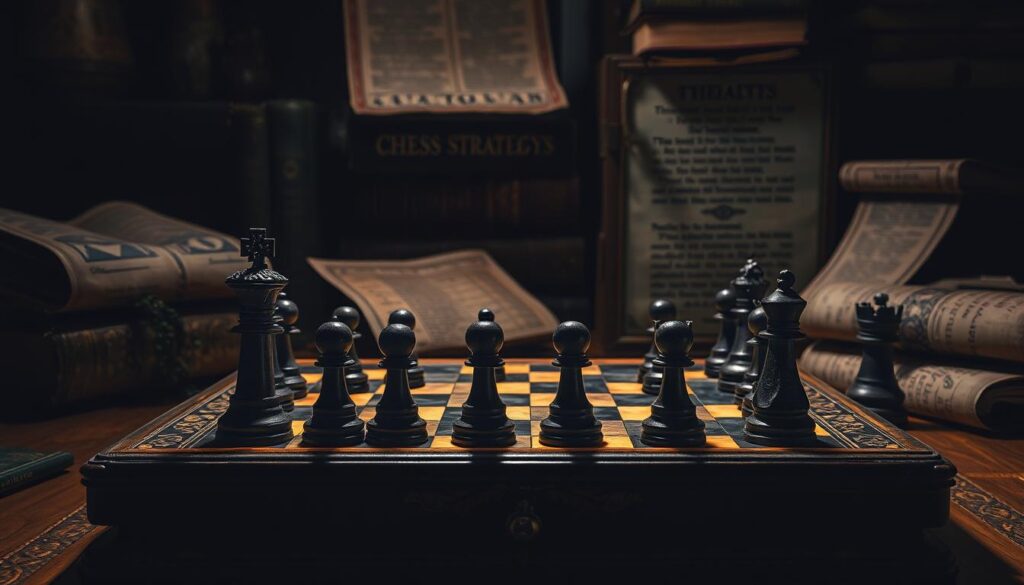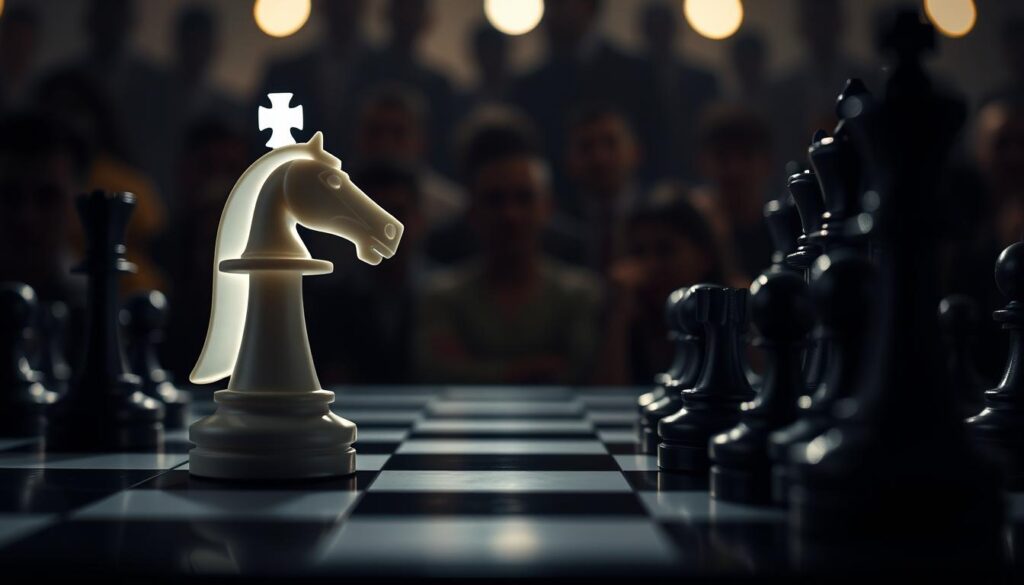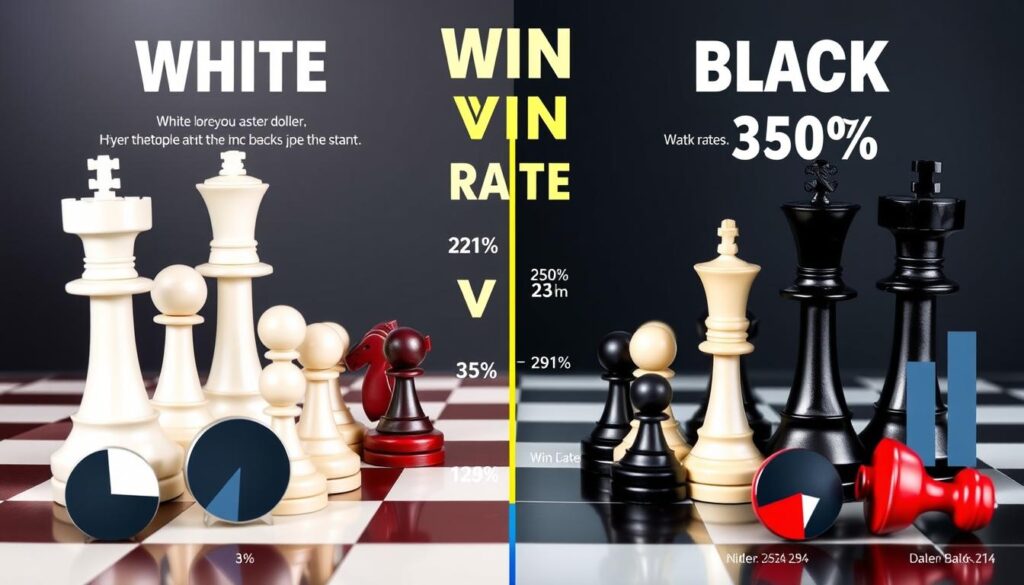Ever felt like winning with black pieces in chess is tough? It’s true. The player with black starts with a small but important disadvantage.
To win with black in chess, you need deep strategic thinking. It’s not just about moving pieces. You must calculate every move carefully. The first-move advantage of white makes it harder for black to start well.
Black in chess faces many challenges in chess. These include opening strategies and the pressure of playing second. Understanding these challenges is key to overcoming them.
Table of Contents
The Historical Perspective of Black’s Disadvantage.(overcoming black’s disadvantages)

The history of black’s disadvantage in chess goes back centuries. It’s rooted in basic strategic challenges. Early chess thinkers saw the second player’s big positional hurdles. In 1735, Joseph Bertin noted a key point: the first player has an attacking edge.
Statistical evidence shows black’s long-standing disadvantage. From 1851 to 1932, detailed game analysis found clear patterns in chess results:
| Period | White Wins | Draws | Black Wins |
|---|---|---|---|
| 1851-1878 | 45.52% | 14.07% | 40.41% |
| 1881-1914 | 36.89% | 31.76% | 31.35% |
| 1919-1932 | 36.98% | 36.98% | 26.04% |
Chess strategy has evolved, showing Black’s structural challenges. Traditionally, White starts the attack and keeps the pressure. Black’s main goal is to counter this and aim for a fair game.
Today’s chess analysis still backs up these old ideas. In the 2009 World Blitz Chess Championship, White won 38.96% of the time. Black in chess won 34.63%, showing the ongoing strategic gap.
Knowing this history helps chess players tackle black’s challenges. It turns what seems like a disadvantage into a strategic chance.
Why Is it Hard to Win with Black in Chess

Playing chess with black pieces is tough. The main issue is responding to White’s first move. This gives White an early advantage. Black in chess must use precise strategies to fight back.
Black’s journey starts with White’s first move. This means you have to react quickly to their plan. You need to develop defensive moves to stop White’s attacks.
There are various defensive openings to help. Let’s look at some:
| Opening | Key Characteristics | Difficulty Level |
|---|---|---|
| Sicilian Defense | Robust response to 1.e4 | Intermediate |
| French Defense | Disrupts White’s central control | Beginner Friendly |
| King’s Indian Defense | Advanced positional strategy | Advanced |
Mastering black’s defensive strategies takes practice and study. Practice and deep study of opening principles can help you overcome the disadvantage of playing black.
Even with challenges, skilled players can turn defensive moves into wins. This is done through careful planning and strategic thinking.
Understanding White’s First-Move Advantage

Chess players know the power of the first move. White gets a big edge at the start. This lets White control the game early on.
Studies show White wins about 54-56% of games against skilled players. This means White gets a 35-point rating boost just by moving first.
| Time Period | White Win Percentage | Draw Percentage | Black Win Percentage |
|---|---|---|---|
| 1851-1878 | 45.52% | 14.07% | 40.41% |
| 1919-1932 | 36.98% | 36.98% | 26.04% |
| World Blitz Chess Championship 2009 | 38.96% | 26.41% | 34.63% |
The first move gives White big benefits. White picks the opening and sets the game’s pace. This puts Black on the defensive, trying to counter White’s early moves.
Even top players like Jonathan Rowson agree. The first-move advantage is real at all levels. Players aiming to play Black in chess need to learn how to counter this advantage.
Statistical Analysis of White vs. Black Win Rates

Looking into chess win rates, we find an interesting pattern. White has a clear edge over Black in chess games. The numbers show a big difference in who wins, not just by chance.
A detailed study of chess games shows an interesting trend. White wins about 54.95% of the time, while Black wins only 27.60%. The rest, 34.90%, end in a draw. This shows how complex chess can be.
| Player Color | Win Percentage | Draw Percentage |
|---|---|---|
| White | 54.95% | 34.90% |
| Black | 27.60% | 34.90% |
As players get better, the win rate gap widens. Top players show a huge difference in White and Black wins. This suggests the first-move advantage is key in winning games.
Player ratings also play a big role. A 100-point difference in ratings means a 75% win rate for the higher-rated player. This shows how skill affects game results.
Knowing these stats can help you play Black better. It can turn what seems like a disadvantage into a chance for creative play.
Psychological Challenges When Playing Black in Chess
Playing chess with the black pieces starts a unique battle in your mind. You must adopt a defensive mindset from the start. This can make you feel under pressure and doubt your decisions.
Being black in chess requires a lot of mental strength. You know white will set the pace at the beginning. This can make you feel like you’re already behind, affecting your game.
Chess experts say managing these mental hurdles needs special strategies. You need to build a strong mental game. This way, you can turn weaknesses into chances for creative moves.
| Psychological Challenge | Mental Strategy |
|---|---|
| Defensive Initial Position | Proactive Counterattack Mindset |
| Reduced Initial Control | Strategic Flexibility |
| Potential Psychological Intimidation | Confident Preparation |
Grandmasters know that chess is as much about psychology as it is about skill. Your mindset can change how you see playing black in chess. Seeing it as a chance for new strategies can change your game.
Opening Theory Disadvantages for Black
Chess opening theory brings unique challenges for Black players. When you start playing chess, you notice White’s first move gives them an edge. This initial move allows White to shape the game’s early stages more freely.
Black’s strategies must be well-thought-out and precise. Defenses like the Sicilian (1.e4 c5) and Caro-Kann (1.e4 c6) aim to counter White’s early lead. These openings need a deep understanding and strategic planning.
| Opening | White Win Rate | Black Counterplay Potential |
|---|---|---|
| Sicilian Defense | 52.3% | High |
| Caro-Kann Defense | 57% | Medium |
| French Defense | 55% | Medium-High |
Understanding chess opening theory is key for Black. You must anticipate different moves, grasp complex ideas, and create strong counterstrategies. The pressure of responding to White’s move can be intense.
Modern chess requires thorough preparation. With computers revealing detailed opening insights, Black must keep adapting and finding new ways to counter White’s first-move advantage.
Positional Challenges in the Middlegame
Understanding chess middlegame strategy is key. As Blackin chess, you’ll face complex challenges that need careful planning and tactical thinking.
The middlegame starts around move 10-15. Black often struggles with significant positional issues. White’s early moves can give them space and flexible piece placement.
As Black in Chess, focus on strategic principles. Centralize your pieces, keep them coordinated, and create counterplay. Being alert is crucial, as mistakes can change the game’s direction.
| Middlegame Strategic Challenges | Black’s Key Considerations |
|---|---|
| Space Disadvantage | Counterattack and piece activity |
| Cramped Positions | Piece exchanges and dynamic play |
| White’s Initiative | Creating tactical complications |
Tactical skills are vital in the middlegame. Learning to use pins, forks, and discovered attacks can counter White’s advantages. Your aim is to create counterplay and balance the game.
Studying classic games is advised. Analyzing grandmasters’ strategies can help you develop better approaches as Black.
Modern Approaches to Playing Black in Chess
Modern chess strategies have changed how players play as black. No longer do they just aim for equality. Today, they seek out unbalanced positions that offer real counterplay.
The Sicilian Defense is a top example of these strategies. It creates an immediate imbalance, challenging white’s control right away. By picking lines that lead to tactical battles, black turns defense into offense.
Now, black players focus on strategic variety. They choose openings that offer many paths, keeping opponents on their toes. This makes the game less predictable.
| Opening | Strategic Characteristic | Tactical Potential |
|---|---|---|
| Sicilian Defense | Asymmetrical Position | High Complexity |
| King’s Indian Defense | Aggressive Counterattack | Strategic Depth |
| Nimzo-Indian Defense | Flexible Pawn Structure | Positional Advantages |
Players like Magnus Carlsen show that black can be the aggressor. It’s all about understanding deep positions and finding counterplay, even in tough starts.
When playing black, aim for dynamic piece placement and central control. Also, create unpredictable tactical scenarios that challenge old defensive ideas.
Strategic Compensation Methods for Black in Chess
Chess players playing Black must find ways to overcome their disadvantage. By using smart strategies, you can turn weaknesses into strong points on the board.
Black’s strategies focus on creating dynamic imbalances. Knowing key tactics helps you counter White’s early lead. This way, you can create chances to play back at different game stages.
| Strategic Method | Key Objective | Potential Impact |
|---|---|---|
| Hypermodern Openings | Control center indirectly | Disrupt White’s traditional development |
| Active Piece Placement | Generate dynamic tension | Create counterplay opportunities |
| Targeted Structural Weaknesses | Exploit opponent’s positional flaws | Equalize game potential |
Fianchetto setups are great for Black to fight for the initiative. By placing bishops on long diagonals, you can put pressure. This creates complex situations that challenge White’s usual advantages.
Experts say to be flexible and creative when playing Black. Knowing how to control tempo, interact with pieces, and make strategic sacrifices can turn tough spots into wins.
The Impact of Computer Analysis on Black’s Play
Chess engines have changed how players see the game, mainly for those playing black. They’ve shown new ways to think about the game that challenge old ideas.
Modern engines like Stockfish offer deep analysis. With an Elo rating over 3500, they spot details that humans might miss.
| Chess Engine | CCRL Rating | Key Characteristics |
|---|---|---|
| Stockfish | 3564 | Aggressive, board control |
| Komodo | 3508 | Defensive, pawn structure focus |
Chess engines have found key weaknesses in Black’s play. They suggest moves that open up new strategies. They show that having more pieces isn’t always the best.
Advanced engines have changed how we think about openings, mainly for Black. Computational analysis now provides players with strategic compensation methods that were once unknown or overlooked.
At the top levels, engines show Black can beat White’s first-move advantage. This new way of playing has greatly improved Black’s options.
Professional Players’ Perspectives on Black’s Challenges
Exploring grandmaster opinions on playing Black shows a complex world of strategic challenges. Top players say the initial disadvantage for Black is not too big. It just needs great skill and preparation.
Magnus Carlsen, with a GI score of 160, shows that elite players can beat White’s first-move advantage. His strategy shows that Black’s success comes from understanding small positional changes and being mentally ready.
Recent world championship matches show how accurate top players are. In the Singapore match between Ding and Gukesh, players missed only 0.4 points on average. This shows they have developed smart strategies to overcome early disadvantages.
Grandmasters say White has a statistical advantage at first, but Black can turn things around with creative middlegame plans. The secret is to play actively and know your theory well.
| Player | GI Score | Average Missed Points |
|---|---|---|
| Magnus Carlsen | 160 | 0.43 |
| Viswanathan Anand | 140 | 0.43 |
Chess experts always say mastering Black’s position needs flexibility, deep study, and a strong mental game. This helps overcome the early structural challenges.
Conclusion
Chess players today face unique challenges when playing Black in chess. But, the future of chess strategy is full of exciting opportunities for innovation. To overcome Black’s disadvantage, you need to understand strategic nuances well.
Exploring dynamic opening approaches like the Sicilian Defense or King’s Indian Defense is key. Your success with Black pieces also depends on mental resilience and creative thinking. Professional players show that smart preparation and adaptable strategies can counter White’s initial advantage.
The modern chess landscape pushes players to develop sophisticated tactics. These tactics can turn traditional defensive positions into powerful counterattacks. The evolving world of chess challenges old ideas about playing Black in chess.
By embracing advanced strategic approaches and keeping a growth mindset, you can turn weaknesses into strengths. The future of chess strategy is about thinking outside the box and creating unexpected moves on the chessboard.
As chess theory grows, players have more tools to level the playing field. overcoming black’s disadvantages is now about proactive, innovative gameplay. This kind of play keeps opponents guessing and opens up winning chances from tough starting positions.
FAQ
Why is it harder to win with Black in chess?
Black faces many challenges, like responding to White’s first move. They also have to deal with White’s initiative and often play on defense. White wins 52-56% of games, which is about 35 rating points more than Black.
How significant is White’s first-move advantage?
White’s first-move advantage is huge. In the Chessgames.com database, White won 54.95% of games out of 739,769 analyzed. This lets White pick the opening and set the game’s direction early on.
What psychological challenges does Black face?
Playing Black can be tough mentally. Black must equalize instead of taking the lead. This defensive mindset can lower confidence and make it hard to play proactively.
How do top players compensate for Black’s disadvantage?
Top players like Magnus Carlsen use dynamic strategies. They create counterplay and practical chances. This includes making position imbalances and targeting White’s weaknesses.
Are there any effective opening strategies for Black?
The Sicilian Defence is a good choice, giving White only a 52.3% win rate. Hypermodern openings and fianchetto setups also help Black fight for the initiative and balance White’s advantage.
How has computer analysis impacted Black’s play?
Computer engines have shown new strategies and challenged old beliefs. But, at the top level, the number of decisive games is almost zero. White wins almost all decisive games.
Can Black truly compete at the highest levels of chess?
While it’s statistically tough, top grandmasters find ways to counter White’s advantage. Some say Black’s chances are often underestimated. Modern play can create real winning chances.
What is the most critical phase for Black in a chess game?
The opening phase is key for Black. Many openings need precise play to equalize. Black must carefully counter White’s initiative and look for counterplay chances.
Has the perception of Black’s disadvantage changed over time?
Yes, modern chess theory now focuses on dynamic and unbalanced positions for Black. Players like András Adorján say the disadvantage is more psychological than real.
What do professional players say about playing Black?
Opinions differ. Grandmasters like Evgeny Sveshnikov think White’s advantage grows with player strength. Others believe Black’s chances are underestimated. The key is understanding the unique challenges and staying positive.
















